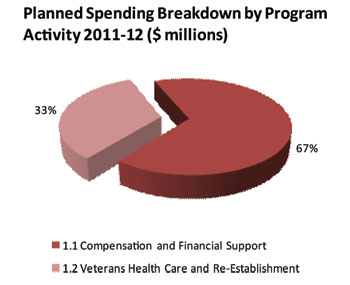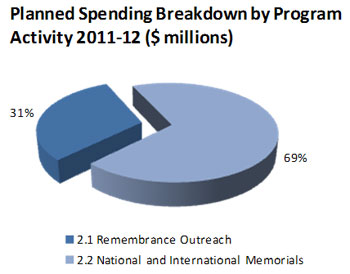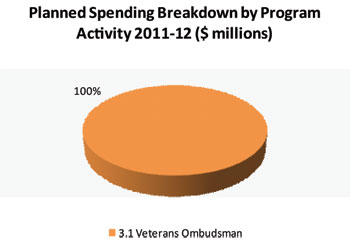Common menu bar links
Breadcrumb Trail
ARCHIVED - Veterans Affairs Canada - Report
 This page has been archived.
This page has been archived.
Archived Content
Information identified as archived on the Web is for reference, research or recordkeeping purposes. It has not been altered or updated after the date of archiving. Web pages that are archived on the Web are not subject to the Government of Canada Web Standards. As per the Communications Policy of the Government of Canada, you can request alternate formats on the "Contact Us" page.
Section II - Analysis of Program Activities by Strategic Outcome
Strategic Outcome #1 - Well-Being of Eligible Veterans and Other Individuals VAC Serves
Veterans Affairs Canada repays the nation’s debt of gratitude towards the men and women who have proudly served Canada in times of war, conflict and peace.
To ensure their continued well-being after release, VAC provides access to programs and services aimed at meeting their physical, psycho-social and financial needs. The comprehensive and integrated suite of programs available includes: Disability Benefits, Financial Benefits, Healthcare Benefits, the Veterans Independence Program, and the Vocational, Medical and Psycho-social Rehabilitation Program.

| Year | Financial Resources ($ millions) |
Human Resources (FTEs) |
|---|---|---|
| 2011-12 | 3,388.5 | 2,726.0 |
| 2012-13 | 3,165.5 | 2,726.0 |
| 2013-14 | 3,164.6 | 2,726.0 |
The Department contributes to well-being of Veterans by:
- Maintaining responsive and innovative departmental programs and services that are supported by a national Mental Health Strategy and comprehensive Case Management;
- Conducting and partnering on research projects that support advancement in areas such as mental health; and
- Partnering with the Canadian Forces on Integrated Personnel Support Centres.
In the next three years, key priorities include:
- Re-engineering policies and processes to reduce complexity;
- Reducing the time it takes to render disability benefit and rehabilitation program decisions;
- Providing Veterans with easier and faster access to needed health benefits; and,
- Enhancing case management to better support individuals with complex needs.
Program Activity 1.1: Compensation and Financial Support
| Human Resources (FTEs) and Planned Spending ($ millions) | |||||
|---|---|---|---|---|---|
| 2011–12 | 2012–13 | 2013–14 | |||
| FTEs | Planned Spending | FTEs | Planned Spending | FTEs | Planned Spending |
| 909 | 2,263.9 | 909 | 2,007.2 | 909 | 2,007.2 |
| Expected Results | Performance Indicators | Targets |
|---|---|---|
| War Service and Canadian Forces Veterans, Canadian Forces members and still serving and retired members of the Royal Canadian Mounted Police feel the disability compensation that they have received from Veterans Affairs Canada recognizes their service-related disability | Percentage of eligible Veterans and other individuals VAC serves who feel the disability benefits they have received from Veterans Affairs Canada has recognized their service-related disability | 65% |
| Eligible Veterans and other individuals VAC serves do not experience low income | Percentage of Canadian Forces Veterans with family incomes below the Low Income Measure | <10% |
Planning Highlights
Legislation was tabled to improve NVC benefits to meet the unique, changing needs of today’s Veterans. If passed, this legislation will improve financial benefits for severely disabled Veterans, ensure a minimum annual income for those participating in rehabilitation and provide more flexible disability award payment options to CF members and Veterans.
The Department will focus on providing faster access to disability benefits by reducing internal complexity and the time required to render decisions.
Benefits for Canadians
Canadians are assured that Veterans will be provided programs and services that support their well being and the re-integration of Canadian Forces Veterans and their families to civilian life.
Program Activity 1.2: Veterans Health Care and Re-Establishment
| Human Resources (FTEs) and Planned Spending ($ millions) | |||||
|---|---|---|---|---|---|
| 2011–12 | 2012–13 | 2013–14 | |||
| FTEs | Planned Spending | FTEs | Planned Spending | FTEs | Planned Spending |
| 1,817 | 1,124.6 | 1,817 | 1,158.3 | 1,817 | 1,157.4 |
| Expected Results | Performance Indicators | Targets |
|---|---|---|
| Veterans in receipt of home care services through the Veterans Independence Program are able to remain in their own homes and communities | Percentage of community dwelling Veterans in receipt of the Veterans Independence Program who are admitted to a long term care facility during the fiscal year | <10% |
| Canadian Forces Veterans who are not retired or totally disabled actively participate in the civilian workforce | Percentage of Veterans who are not retired or totally disabled who actively participate in the workforce | 80% |
| War Service and Canadian Forces Veterans, Canadian Forces members , still serving and retired members of the RCMP report "good", "very good" or "excellent" mental health | Percentage of eligible Veterans and other individuals VAC serves who report "good", "very good" or "excellent" mental health | 70% |
Planning Highlights
VAC will provide faster access to needed treatment benefits by streamlining approvals and placing more reliance on the treating health professionals.
The Department will reduce the administrative burden and provide faster payments for those receiving VIP benefits.
VAC will continue to delegate greater authority for decisions relating to rehabilitation plans to front line staff in order to provide faster, more effective service for those who are participating in the Rehabilitation Program while at the same time maintaining due diligence on files.
The Department will continue discussions and negotiations with the Province of Quebec about the potential transfer of Ste. Anne’s Hospital, while ensuring that Veterans continue to receive care and the Hospital’s expertise in geriatrics and psycho geriatrics is maximized.
Benefits for Canadians
Canadians will be assured that Veterans are provided access to health benefits and rehabilitation services, more specifically in areas such as mental health, case management and home care.
Strategic Outcome #2 - Canadians Remember and Demonstrate Their Recognition Of All Those Who Served in Canada’s Efforts During War, Military Conflict and Peace
Generations of Canadian Veterans, through their courage, determination and sacrifice have helped to ensure that Canadians are able to live in a free and peaceful country. Perpetuating the remembrance of their contributions is ultimately dependent on a Canadian population that is engaged in acknowledging their achievements and sacrifices through remembrance based activities.
Remembrance activities are an essential component of ensuring that future generations understand the high cost of freedom and the importance of protecting human rights, freedom and justice around the world.

| Year | Financial Resources ($ millions) |
Human Resources (FTEs) |
|---|---|---|
| 2011-12 | 41.4 | 101 |
| 2012-13 | 44.6 | 101 |
| 2013-14 | 44.6 | 101 |
VAC contributes to ongoing remembrance by:
- Leading and supporting ceremonies and events in Canada and abroad that recognize and honour Canada’s war dead and Veterans;
- Providing remembrance based resources (a wide range of learning materials using a variety of media) for Canadian youth and educators;
- Establishing and leveraging partnerships that extend the reach of Veterans Affairs Canada’s remembrance mandate;
- Providing funeral, burial and grave marking assistance in partnership with the Last Post Fund Corporation;
- Maintaining war graves and memorials in partnership with the Commonwealth War Graves Commission;
- Maintaining VAC owned cemeteries and Veterans' graves in Canada; and
- Preserving and interpreting memorials in Europe that symbolize Canada’s sacrifice during the two World Wars.
In the next three years, key priorities include:
- Increasing the awareness and participation of Canadians in remembrance activities;
- Bringing remembrance to Canadians by increasing corporate involvement in remembrance activities and by using modern technology and continuing the successful use of social media;
- Increasing the recognition of Canadian Forces Veterans and changing programming to reflect how they wish to be recognized; and
- Implementation of the new Community War Memorial Program.
Program Activity 2.1: Remembrance Outreach
| Human Resources (FTEs) and Planned Spending ($ millions) | |||||
|---|---|---|---|---|---|
| 2011–12 | 2012–13 | 2013–14 | |||
| FTEs | Planned Spending | FTEs | Planned Spending | FTEs | Planned Spending |
| 78 | 12.8 | 78 | 13.6 | 78 | 13.6 |
| Expected Results | Performance Indicators | Targets |
|---|---|---|
| The memory of the achievements and sacrifices of those who served Canada in war, military conflict and peace is preserved | Percentage of Canadians aware of the achievements and sacrifices of Canadian Veterans | 70% |
Planning Highlights
VAC is committed to increasing the awareness and participation of Canadians in remembrance activities. Commemorating and recognizing Veterans, both traditional and Canadian Forces, helps to keep the memories of their achievements and sacrifices alive for all Canadians.
The Department will focus on creating better awareness among Canadians of the actions of Veterans, including greater recognition of Canadian Forces Veterans.
VAC will develop and strengthen corporate partnerships in order to increase the participation of the private sector in commemoration.
The Department will continue to consult with Canadian Forces and traditional Veterans, stakeholders and Canadians to ensure remembrance activities reflect how they wish to see Canadian Veterans honoured and recognized.
VAC will make effective use of partnerships and technology to build on activities aimed at strengthening youth involvement in remembrance activities.
The Department will begin planning commemorative initiatives to mark the 2014-2018 centennial anniversaries of the First World War and other upcoming significant military anniversaries.
Benefits for Canadians
Canadians, especially youth will be informed about our military history through commemorative efforts that recognize and honour those who served Canada in times of war, military conflict and peace.
Program Activity 2.2: National and International Memorials
| Human Resources (FTEs) and Planned Spending ($ millions) | |||||
|---|---|---|---|---|---|
| 2011–12 | 2012–13 | 2013–14 | |||
| FTEs | Planned Spending | FTEs | Planned Spending | FTEs | Planned Spending |
| 23 | 28.6 | 23 | 31.0 | 23 | 31.0 |
| Expected Results | Performance Indicators | Targets |
|---|---|---|
| Canadian Veterans and war dead are recognized and honoured in death | Percentage of Canadians who feel it is important that Veterans Affairs Canada maintains memorials, cemeteries, grave markers and provides funeral and burial assistance | 75% |
Planning Highlights
The Department will continue to honour the sacrifices made by Veterans through ongoing maintenance and improvements of memorials, cemeteries and grave markers. In particular, VAC will focus on signage and maintenance at the Canadian National Vimy Memorial at Vimy Ridge, improving interpretation at the National War Memorial in Ottawa and at the European Memorial sites, which receive over one million visitors annually.
Benefits for Canadians
Canadians are assured that memorials, cemeteries and grave markers of our war dead will be maintained as lasting symbols that honour the sacrifices and accomplishments of those who bravely served Canada in war and peace.
Strategic Outcome #3 - Veterans and Other Individuals the Ombudsman Serves Receive an Independent and Impartial Review of VAC Related Complaints
The Veterans Ombudsman exists to promote the fair and equitable treatment of Veterans and/or their representative who have applied for, or are in receipt of, benefits and services from VAC.
To accomplish this, the Office of the Veterans Ombudsman provides Veterans and other individuals with information and referrals to facilitate their access to programs and services and provides them with the opportunity to request an independent review of their complaint by an impartial individual who was not part of the original decision-making process.

| Year | Financial Resources ($ millions) |
Human Resources (FTEs) |
|---|---|---|
| 2011-12 | 5.9 | 40 |
| 2012-13 | 5.9 | 40 |
| 2013-14 | 5.9 | 40 |
The Veterans Ombudsman has the mandate to:
- Review and address complaints arising from the application of the provisions of the Veterans Bill of Rights;
- Review and address complaints related to programs and services provided or administered by the Department or by third parties on the Department’s behalf, including individual decisions on benefits and services for which there is no right of appeal to the Veterans Review and Appeal Board;
- Identify, research and investigate emerging and existing systemic issues related to the provisions of the Department’s programs and services;
- Review systemic issues related to the Board; and
- Provide information and recommendations to the Minister in relation to identified systemic issues.
Program Activity 3.1: Veterans Ombudsman
| Human Resources (FTEs) and Planned Spending ($ millions) | |||||
|---|---|---|---|---|---|
| 2011–12 | 2012–13 | 2013–14 | |||
| FTEs | Planned Spending | FTEs | Planned Spending | FTEs | Planned Spending |
| 40 | 5.9 | 40 | 5.9 | 40 | 5.9 |
| Expected Results | Performance Indicators | Targets |
|---|---|---|
| Veterans and their families are aware of and have access to the Ombudsman Services | Percentage of Veterans and their families surveyed that feel they have access to and are aware of the services that the Ombudsman offers | 80% |
| Veterans and their families are aware of the issues and recommendations raised by the Ombudsman's Office | Percentage of Veterans and their families surveyed that have an awareness of the issues raised by the Ombudsman Office | 80% |
| Observations and reports submitted to the Department are acknowledged | Percentage of responses to observations and reports submitted to the Department | 80% |
Planning Highlights
The Office of the Veterans Ombudsman will continue early intervention activities so that complaints are resolved in a timely and appropriate manner.
The Office of the Veterans Ombudsman will focus on initiating and investigating three systemic issues.
By maintaining public consultation initiatives (including web-based approaches, town halls and speaking platforms) aimed at engaging Veterans and other stakeholders, the Office of the Veterans Ombudsman will be better able to identify and inform all stakeholders on issues of concerns and emerging priorities.
Benefits for Canadians
Canadians are assured that Veterans will be afforded the benefits, services and support that they are due and that none will be left behind. Veterans are assured that their rights, as outlined in the Veterans Bill of Rights, are upheld and that they have a voice in the Ombudsman who will address their concerns.
4.1 Internal Services
| Human Resources (FTEs) and Planned Spending ($ millions) | |||||
|---|---|---|---|---|---|
| 2011–12 | 2012–13 | 2013–14 | |||
| FTEs | Planned Spending | FTEs | Planned Spending | FTEs | Planned Spending |
| 798 | 87.4 | 798 | 84.4 | 798 | 84.4 |
Planning Highlights
Internal Services are groups of related activities and resources that are administered to support the needs of programs and other corporate obligations of an organization.
These groups include Management and Oversight Services, Communications Services, Legal Services, Human Resources Management Services, Financial Management Services, Information Management Services, Information Technology Services, Real Property Services, Materiel Services, Acquisition Services, and Travel and Other Administrative Services.
Internal Services include only those activities and resources that apply across an organization and not to those provided specifically to a program.
VAC is a participant in the Federal Sustainable Development Strategy (FSDS) and contributes to Greening Government Operations targets through the Internal Services Program Activity. VAC’s Sustainable Development Strategy also covers the support services provided to the Veterans Review and Appeal Board under a Memorandum of Understanding.
Benefits for Canadians
Canadians are assured that programs and services are managed using sound management principles in areas such as planning, budgeting, reporting and communicating to Canadians.
